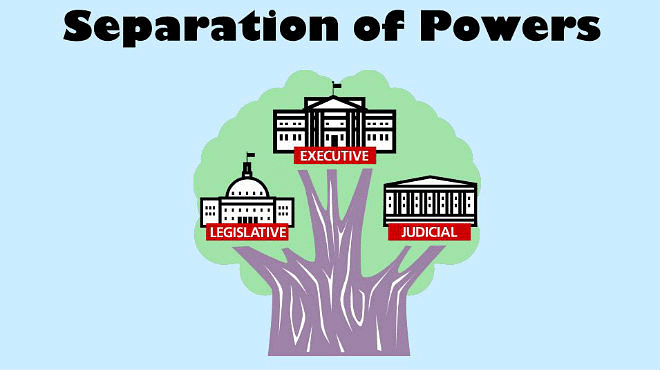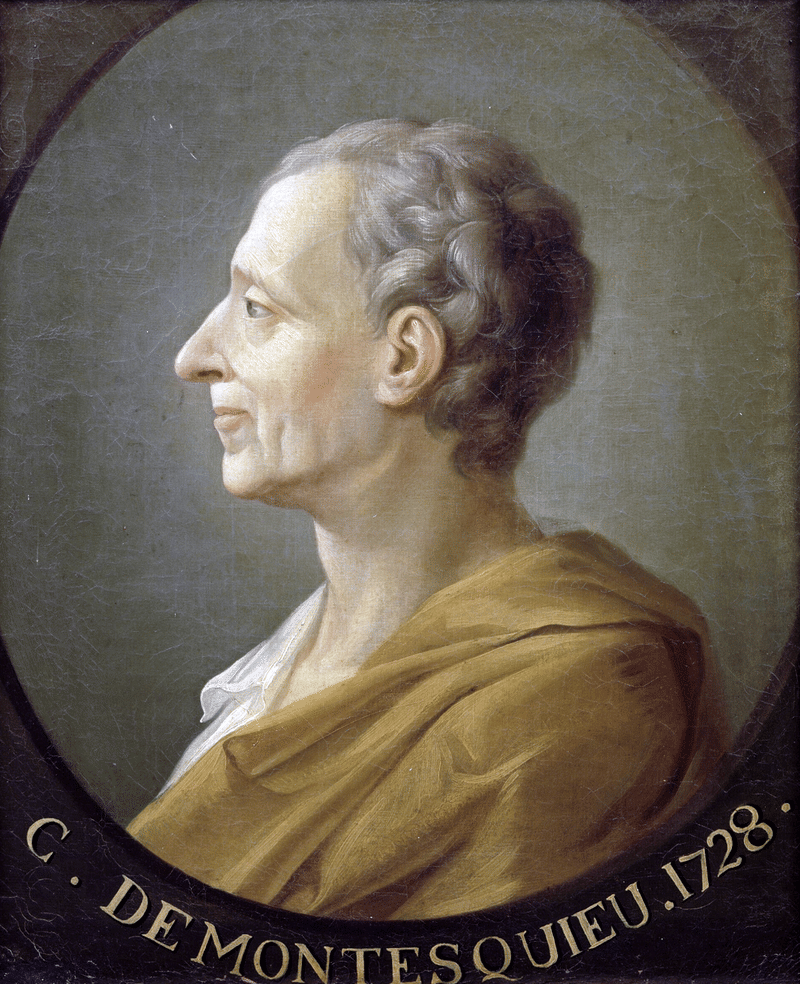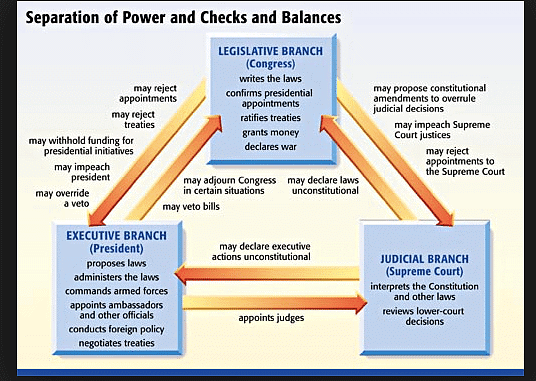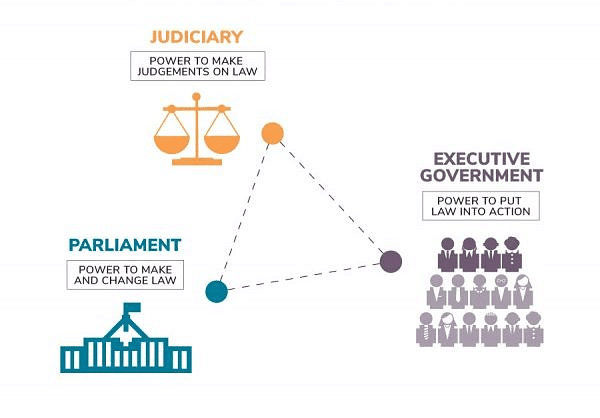Separation of Powers Chapter Notes | Legal Studies for Class 11 - Humanities/Arts PDF Download
Concept of Separation of Powers

- Definition of Separation of Powers: The concept implies that governmental functions should be divided among three distinct authorities, each independent and operating within its own sphere.
- Distinctness of Government Organs: The three branches of government must remain separate and distinct, with no one organ controlling the others. Encroachment on each other's powers is prohibited.
- Checks and Balances: If any organ oversteps its authority, it should be restrained by another branch. This system prevents the creation of new organs to oversee encroachments.
- Constitutional Requirement: A written constitution is necessary to delineate the formal powers of each branch, ensuring a system of checks and balances among them.
- Carl J. Friedrich's Perspective: This concept is supported by the ideas of Carl J. Friedrich, a German-American political theorist.
- Interpretations of Separation of Powers:
- The same individual should not serve in more than one branch of government.
- No branch should control or interfere with the functions of another.
- No branch should assume the functions of another.
Historical Background and Evolution of Montesquieu’s Doctrine of Separation of Powers

A. Montesquieu's Doctrine of Separation of Powers
- Origin: French philosopher Baron De Montesquieu (1689-1755) elucidated the concept of separation of powers in the 18th century.
- Significance: Montesquieu's theory on separation of powers serves as a governance model for democracies.
- Inspiration: Montesquieu developed his theory after observing the oppressive rule of French King Louis XIV (1661-1715).
- Comparison: He contrasted the despotic French system with the more liberated English governance during his visit to England.
- Key Work: Montesquieu's ideas were formalized in his renowned book "Esprit Des Lois" (The Spirit of Laws) published in 1748.
B. Basic Features of Montesquieu's Doctrine of Separation
Theory of Separation of Powers
- Montesquieu proposed the theory of separation of powers, advocating for a clear division of governmental authority into legislative, executive, and judicial branches.
Reasons for Division of Powers
- Separation Prevents Tyranny: When legislative and executive powers are consolidated, liberty is threatened because the same authority could create and enforce laws arbitrarily.
- Protecting Individual Rights: Combining judicial and legislative powers could endanger personal freedoms since judges might make laws, leading to arbitrary control.
- Preventing Oppression: When judicial and executive powers unite, there's a risk of oppressive behavior as judges become both prosecutor and judge, concentrating too much power.
- Ensuring Effective Governance: Divided powers ensure effective governance by preventing concentration of authority in one organ, thereby promoting accountability and efficiency.
Inherent Abuse of Powers
- Any authority, if unchecked, tends to abuse its powers.
- Hence, limitations are essential to ensure that each branch of government operates within its designated sphere.
C. Checks and Balances
To safeguard liberty, each branch of government must act within its own sphere and oversee the actions of the other branches.
a. Executive Checks: The executive oversees the legislative and judicial branches to prevent overreach.
b. Legislative Checks: The legislature monitors the executive and judicial branches to prevent abuse of power.
c. Judicial Checks: The judiciary reviews the actions of the executive and legislative branches to ensure they adhere to legal principles.
This system of 'checks and balances' ensures that no branch becomes too powerful, maintaining a balance that prevents tyranny and promotes the rule of law.

D. Impact of the Doctrine
- Montesquieu supported implementing this doctrine in his own country's political system.
- His teachings significantly influenced the French Revolution and led to the enactment of the Declaration of Rights in 1789.
- The Declaration emphasized that societies lacking Separation of Powers lack a Constitution. The French Constitution of 1791 established the executive, legislative, and judiciary as independent entities.
- James Madison in The Federalist argued against consolidating all powers in one entity, defining it as tyranny.
- The concept of Separation of Powers is fundamental to the U.S. Constitution of 1787, with Montesquieu being credited as a key influence on the American Constitution.
Evaluation of The Doctrine of Separation of Powers
The doctrine of separation of powers can be understood in two main ways:
- It suggests avoiding concentration of powers in one person or group.
- It involves dividing powers that belong to one organ, allowing allied functions with coordination.
A. Key Benefits and Advantages of the Doctrine of Separation of Powers
- Different personnel with unique capabilities for each organ enhance efficiency and administration.
- Safeguards individual liberty and freedom by ensuring each organ acts within the law.
- Establishes an independent judiciary to act as a check and balance among the organs.
- System of check and balances promotes stability in governance and protects state sovereignty.
 |
Download the notes
Chapter Notes: Separation of Powers
|
Download as PDF |
B. Defects of the Doctrine
- Historical Context: In the past, the British Constitution did not have a clear separation of powers as suggested by Montesquieu. A. V. Dicey noted that it had a "weak Separation of Powers."
- British Constitution: The British Constitution is not written down in one document but is found in various written sources like statutes, court rulings, and treaties. The Parliament can change the Constitution by passing new laws.
- Roles of Government Organs: The three branches of government - legislature, executive, and judiciary - are interconnected. They have distinct functions: the legislature debates, the executive implements laws, and the judiciary evaluates laws and executive actions.
- Challenges of Extreme Separation: Complete separation of powers can hinder government unity, while excessive checks and balances can lead to inefficiency. Each organ can perform functions that overlap with others.
- Quote by Lord Acton: Lord Acton famously said, "Power tends to corrupt, and absolute power corrupts absolutely," highlighting the risks of unchecked authority.
- Functions Over Powers: Viewing government roles as functions rather than powers emphasizes service over force. Different organs perform distinct functions to serve the state and its people.
- Executive in Welfare State: In a welfare state, the executive branch expands to provide essential services like healthcare and education, blurring the lines between legislative and executive functions.
Separation of Powers in Practice
A. Separation of Powers in Britain

Executive
Nominal Executive Head- British monarch (Queen) holds a hereditary position without political powers.
- Real executive authority lies with the Prime Minister and Council of Ministers.
- The Queen acts on advice from the Council of Ministers.
Legislature
Composition and Role- UK Parliament consists of House of Commons and House of Lords.
- Responsibilities include legislation, scrutiny, and debates.
- Prime Minister and Council of Ministers are part of the legislature.
- They make laws, oversee administrative boards, and handle judicial functions related to parliamentary privileges.
Judiciary
Structure and Evolution- Supreme Court established in 2009 by the Constitutional Reform Act 2005.
- Justices titled Lord or Lady for life.
- Previously, House of Lords Appellate Committee served as highest court.
- Constitutional Reform Act 2005 separated powers: Lord Chancellor's role changed to Secretary of State for Justice; Lord Chief Justice now heads judiciary.
B. Separation of Powers in United States of America
 Senate in USA
Senate in USA
Legislature: US Congress
Composition- Consists of two houses: Senate (upper house) and House of Representatives (lower house).
- Senators serve six-year terms, Representatives serve two-year terms.
- Law-making authority vested in Congress.
- Bills subject to presidential ratification or veto (except money bills).
- Senate shares powers with the President for appointments, declaring war, and ratifying treaties.
- Acts judicially in cases of presidential and Supreme Court impeachment.
- Congress cannot be dissolved by the President.
- Override provision for presidential veto by special majority vote.
Executive: US President
Role
- Elected by the people for four-year terms.
- Powers include recommending measures, summoning Congress, and vetoing bills (except money bills).
- Appoints cabinet Secretaries (confirmed by Senate) to head executive departments.
- Formulates national policy, mobilizes military, declares state emergencies.
- Requires Congressional approval to declare war.
- Treaties and policies subject to Senate ratification.
- Power to pardon offenses except treason.
Judiciary: US Supreme Court
Appointment and Powers- Justices nominated by President, ratified by Senate.
- Holds power of judicial review over legislative and executive actions.
- Can declare laws and executive orders unconstitutional under the US Constitution.
C. Separation of Powers in India

- India's governing system is quite similar to that of Britain's, following the Parliamentary System of Government.
- According to the Indian Constitution, the three main branches of Government are the legislature, executive, and judiciary.
- The Parliament in India consists of the President along with two Houses - the Council of States and the House of the People.
Executive
- The President of India serves as the nominal executive head, while the real executive power lies with the Prime Minister and the Council of Ministers.
- The President is elected by the Electoral College comprising elected members from both houses of Parliament and state legislative assemblies.
- The President holds office for a fixed term of 5 years.
- The President possesses extensive legislative powers, including issuing ordinances during the recess of the legislature.
- Additionally, the President can dissolve the House of People and declare various types of emergencies.
Legislature
- The Prime Minister and the Council actively participate in proposing and passing bills in Parliament, which become laws upon the President's assent.
- The Council of Ministers, including the Prime Minister, are collectively accountable to the House of People.
- The Parliament holds the authority to impeach the President.
Judiciary in India
- Judiciary includes the Supreme Court of India, High Courts, and subordinate courts.
- Supreme Court serves as India's final court of appeal.
Independence of Judiciary:
- Various provisions exist in the Constitution to create a separate judiciary.
- Article 50 of the Constitution of India states that the State must ensure the judiciary is distinct from the executive in public services.
- The aim of Article 50 is to guarantee the independence of the judiciary.
- The President appoints Judges of the Supreme Court and High Courts after consulting with specific Judges of these courts, as outlined in Article 124(2) of the Constitution.
- A nine-Judge Constitution Bench of the Supreme Court established the consultation process norms for appointing judges and transferring them.
- The privileges and allowances of a Judge cannot be changed once appointed.
- Parliament cannot discuss the conduct of any Judge of the Supreme Court or High Court, except during impeachment proceedings.
Role of Judiciary:
- The legal system in India interprets the Constitution.
- The courts check laws and government actions to see if they follow the Constitution.
- The judiciary ensures citizens' Fundamental Rights through legal actions like writs filed in the Supreme Court or High Court.
- Courts create their own rules for delivering justice and oversee lower courts.
- Supreme Court and High Court judges can only be removed by the legislature for serious reasons.
- Article 368 of the Constitution outlines how the Parliament can amend the Constitution.
- In a famous case (Keshavananda Bharati case), the Supreme Court said Parliament can't change the Constitution's basic structure.
- The Supreme Court defines what the Constitution's essential features are.
- Some of these features include Constitution's supremacy, democratic government, secularism, and judicial powers.
- The Supreme Court has the final say on what makes up the Constitution's core.
|
69 videos|76 docs|25 tests
|
FAQs on Separation of Powers Chapter Notes - Legal Studies for Class 11 - Humanities/Arts
| 1. What is the concept of Separation of Powers? |  |
| 2. Who is credited with developing the doctrine of Separation of Powers? |  |
| 3. How has the doctrine of Separation of Powers evolved over time? |  |
| 4. How is the doctrine of Separation of Powers evaluated in modern governance? |  |
| 5. Can you provide examples of Separation of Powers in practice? |  |
























